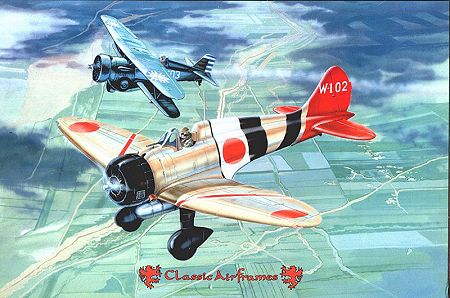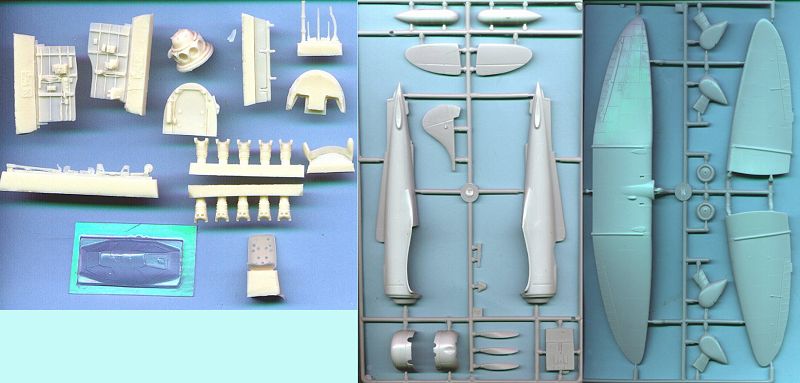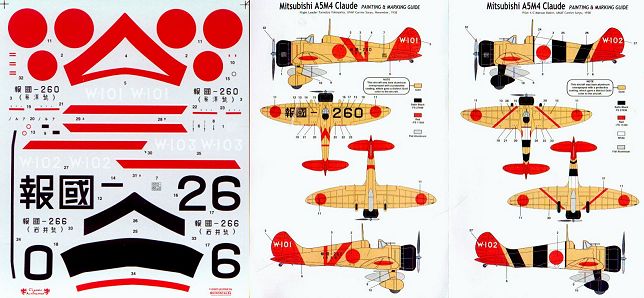
|
KIT: |
Classic Airframes 1/48 A5M4 'Claude' |
|
KIT # |
427 |
|
PRICE: |
$24.95 |
|
DECALS: |
2 aircraft. See writeup |
|
REVIEW & PHOTOS BY: |
|
|
NOTES: |

|
HISTORY |
One wonders why it is that fighter pilots, who operate some of the most advanced aerial technology available, can often be so conservative. Rather than leap into the new, they are generally dragged kicking and screaming into every advance made in the art of fighter aircraft design. Nowhere was this more true than in the transition from the biplane to the monoplane. As early as 1916, Bristol had produced the M.1C "Bullet," 20 mph faster than the new German fighter designs that would destroy in less than six weeks of operations over the Somme the RFC's hard-won air supremacy on the Western Front, and put the service through such meat-grinders as "Bloody April," due to the overwhelming supremacy of the German Albatros over its opponents. RFC reluctance to operate a monoplane due to pre-war accidents that seemed to stress lack of structural strength in the monoplane design led directly to these near-catastrophic losses.
By the 1930s it was clear that if the fighter was to retain its supremacy over its enemy, the bomber, that new technology would have to be embraced; the fighting biplane of the First World War style and simply run out of further opportunity for development and improvement. Fighter pilots, used to the high-g maneuvering of a biplane, believed they would be at a disadvantage flying a monoplane. Thus, many of the early specifications for monoplane fighters required the airplane to exhibit a performance more akin to that achievable with a biplane, rather than stress the strengths of the monoplane and modify fighting tactics accordingly.
Jiro Horikoshi of Mitsubishi was given the task of meeting the Imperial Japanese Navy's imaginative 9-Shi requirements, which had been created by LCDR Sawai Hideo. What was revolutionary about this development was that it did not call for a "carrier fighter" - which all agreed would never meet the performance of its land-based opponents - but a fighter per se, with maximum performance; LCDR Sawai believed that carrier compatibility could be created once the fighter existed.
Horikoshi met the requirements through the most-rigid weight consciousness ever applied to a Mitsubishi design, and by use of the most advanced aerodynamic principles and construction methods. The airplane actually came out weighing less than planned, and was the lightest fighter of its type anywhere in the world. Horikoshi had achieved an airplane with the performance of a monoplane, and the maneuverability of a biplane, albeit by limiting future growth of the design due to the weight-consciousness in its development.
When the airplane was pitted against the Nakajima A4N biplane fighter, Genda Minoru declared the biplane the better fighter. However, when the rules were changed to allow climb-and-dive tactics as well as traditional dogfighting maneuvers, which allowed the monoplane to completely outperform the biplane which could not match it in the vertical plane; even the diehard Genda became a supporter.
The quality of the A5M2 was clearly demonstrated on its first mission, September 19, 1937, in an attack against Chinese airfields around Shanghai. 18 A5Ms led by Lt. Yamashita Shichiro met over 50 Curtiss Hawk IIIs and Boeing 281s (export versions of the P-26) in the course of two missions that day. The IJN pilots claimed 26 of the defending fighters without loss! For the first time, a Japanese airplane that was superior to its Western contemporaries was in service. This would be clearly demonstrated in the battles over Nanking in November and December, 1937, when the A5Ms met the Russian I-152 and I-16 in combat.
The definitive version of the A5M series was the A5M4, which offered increased power with a different engine and increased range with the adoption of a drop tank as standard equipment. The airplane began replacing earlier versions in late 1938. By that time, however, Chinese aerial opposition was vastly reduced from what it had been a year previously. Nevertheless, in early 1939, the A5M4 fought some of the last Soviet units over Hankow, and emerged the winner in these battles, too. By late 1939, the Japanese Navy had largely withdrawn from the Chinese war, and was involved in preparation for the coming Pacific War. The limitations of the A5M were such that a new design was called for, the 14-Shi fighter. Basing the design on the proven characteristics of stringent weight control and maximum usage of modern design technique learned with the A5M, Horikoshi created his masterpiece, the Zero fighter.
|
THE KIT |

For an airplane as important to Japanese aviation history as the A5M is, modelers have been badly served in getting it on their shelves. There was a very old kit in the 1960s which was in 1/50 scale and had moveable control surfaces. There was nothing else in 1/48 injection-molded kit until Fine Molds came out with their very expensive models in the early 1990s. US$70 for a kit was a bit much, and the models never sold well. There was also a Japanese cast resin "garage kit" by T.C. Berg, which had nice surface detail but required a modeler to drill out the interior to create a cockpit. Additionally, Eagles Talon did a vacuform in 1/48, but it was not one of their better creations.
Classic Airframes' A5M4 comes on two sprues of light grey plastic, with a bag of resin for the engine and cockpit interior, with decals for two A5M4s aboard IJN "Soryu" in 1939. Surface detailing is inscribed and petite, with good fabric representation.
Looking at the model, the only difficulty I foresee in construction is the fact that the horizontal stabilizers are somewhat thinner than the faired joint on the fuselage. A short session with a rat-tail file should solve this problem easily.

Painting instructions are interesting, inasmuch as this is the first time I have seen a description of the "gold" color for IJN aircraft. This was the result of a clear yellow lacquer being applied over the natural metal surfaces of the airplane, for protection from salt water corrosion. Classic Airframes suggests painting the airplane with metalizer aluminum, sealing it, then spraying a varnish made of Tamiya clear yellow and Future, applied thinly, to create the final look. This is interesting, and I will certainly be trying this out when I build this kit.
Overall, if you are someone interested in the aircraft of the Imperial Japanese Navy, this is a model you will want to get. With a bit of effort - no more than usual for a limited-run kit - it should turn out to be a good-looking model. It may not be as detailed as a Fine Molds kit, but then again you're saving enough in the price differential to be able to go out and buy a Tamiya Swordfish.